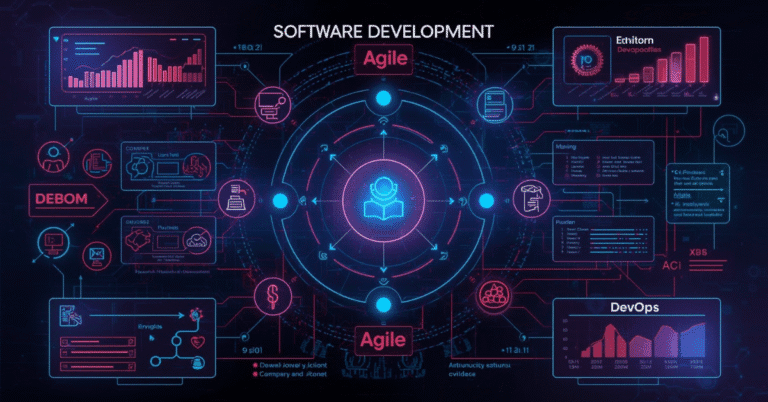
What Is Vibe Coding and Why It’s Taking Over the Developer World in 2025
✨ “Vibe coding is like jazz. You set the mood, drop some notes, and the AI picks up the rhythm.”
— Andrej Karpathy, AI Researcher
Table of Contents
🧠 Introduction: Coding by Vibes?
Imagine writing software not by carefully crafting every line of code… but by expressing your intent, ideas, and vibes — and letting an intelligent AI generate full workflows, APIs, UI components, and even logic trees for you.
Sounds absurd?
Welcome to vibe coding — the latest AI-fueled development trend taking 2025 by storm.
What started as an experimental workflow by AI researchers is now evolving into a serious movement. From solo devs to startups and even enterprise teams, vibe coding is changing how we build digital products.
But is it just a buzzword? Or the future of programming?
Let’s dive in.
🌀 What Exactly Is Vibe Coding?
At its core, vibe coding is a prompt-first, intent-based development style where:
- You converse with an AI assistant (like Copilot, ChatGPT, Cursor, or Replit Ghostwriter),
- Instead of writing detailed code, you describe what you want,
- The AI interprets your “vibes” (language, tone, partial code, examples) and generates working implementations,
- You iterate and adjust with high-level feedback, rarely touching the low-level code directly.
🧩 Think of it like pair programming — except your pair is a 175-billion parameter model that never sleeps.
This style borrows from:
- Natural language programming
- Prompt engineering
- AI agents and copilots
- Codegen tools like CodiumAI, Sweep, and Continue
🧬 Where Did Vibe Coding Come From?
The term “vibe coding” was made popular in early 2025 by Andrej Karpathy, the former Tesla AI lead, during a live coding stream.
Instead of writing traditional boilerplate, he:
- Gave minimal natural prompts to an LLM,
- Let the AI generate classes, functions, and logic,
- Described the outcome he felt should happen,
- Kept adjusting based on intuition and conversational feedback.
This highly non-linear, creative, and vibe-driven workflow shocked developers.
Within weeks, devs across Replit, GitHub, and open-source communities adopted the same approach. Forums, Reddit threads, and YouTube tutorials exploded with the hashtag: #vibecoding.
🛠️ How Does Vibe Coding Actually Work?
Let’s look at a real-world example.
You’re building a blog CMS.
Here’s what vibe coding looks like step by step:
Step 1: You type:
“Make me a simple React component for a post editor. Should support markdown, autosave every 10s, and look minimalistic.”
Step 2: The AI replies with:
jsxCopyEditconst PostEditor = () => {
const [content, setContent] = useState('');
useEffect(() => {
const interval = setInterval(() => {
localStorage.setItem('draft', content);
}, 10000);
return () => clearInterval(interval);
}, [content]);
return (
<textarea
value={content}
onChange={(e) => setContent(e.target.value)}
placeholder="Write your blog..."
/>
);
};
Step 3: You say:
“Looks good. Add toolbar for bold/italic. And integrate with a publish button.”
And it builds the rest.
🧩 The core components of vibe coding:
| Component | Purpose |
|---|---|
| Prompting | Provide intention with high-context input |
| AI Copilot | Generate, explain, and refactor code |
| Feedback Loop | Iterate by reviewing and prompting again |
| Glue Code | Only write code where AI output lacks context |
⚙️ Best Tools for Vibe Coding in 2025
| Tool | Best For | Cost |
|---|---|---|
| Cursor | AI-native IDE with in-file prompting | Free + Pro plans |
| GitHub Copilot X | Seamless VS Code pairing | $10–$20/month |
| Replit AI Ghostwriter | Full-stack vibe workflows | Free + Pro |
| Continue.dev | Open-source Copilot alternative | Free |
| Sweep.dev | AI PR Generator for GitHub Issues | Free |
Bonus: Tools like Bolt, Cody, and Continue support agentic workflows — where AI performs entire tasks from repo scanning to tests and documentation.
💡 Why Developers Are Embracing Vibe Coding
✅ Speed
You can build MVPs, side projects, and prototypes 3–5x faster using vibe coding.
✅ Creativity
Unblocks your brain from boilerplate hell — helps you focus on ideas.
✅ Onboarding
New devs can build real-world apps without deep expertise in every library or API.
✅ Collaboration
AI bridges the communication gap between tech and non-tech team members.
🛑 But There Are Risks
Let’s not get too vibey. Vibe coding isn’t all sunshine.
Useful Links
- Software Development Life Cycle (SDLC) in 2025: Stages, Models, and Modern Practices
- The Rise of Composable Software: Why Developers Need to Think Modular in 2025
- Toil is Back: Why Even with AI, SREs Feel the Burn in 2025
- Best Python Libraries for Automation Developers Overlook in 2025
- Functional Programming in 2025: Are Pure Functions Making a Comeback?
- Why Zig Could Be the Next Big Language for Systems Programming in 2025
❌ Poor Maintainability
AI-generated code often lacks comments, clear structure, or naming conventions.
❌ Security Risks
Copy-pasted or misunderstood output can expose vulnerabilities (e.g., XSS, SQLi).
❌ Debugging Nightmare
AI-generated logic can be hard to debug if it breaks in subtle ways.
❌ Skills Erosion
Heavy reliance on AI may dull your ability to write and understand core logic.
🔐 Vibe Coding vs Traditional Coding: A Quick Comparison
| Feature | Traditional Coding | Vibe Coding (AI-Driven) |
|---|---|---|
| Speed | Slower | Very fast |
| Control | High | Medium |
| Creativity | Moderate | High |
| Debugging | Precise | Often confusing |
| Security | Manual best practices | Needs human review |
| Best Use Case | Production systems | Prototypes, tools, experiments |
🧭 Who Should Use Vibe Coding?
✅ Ideal for:
- Indie hackers
- Solopreneurs
- Startup MVP builders
- Hackathon teams
- Junior devs learning fast
❌ Not ideal for:
- Critical banking/medical systems
- Compliance-heavy industries
- Projects needing extreme long-term maintainability
🧪 Real Use Case: Building a Blog Tool in a Day
A developer named Lisa used Replit’s vibe coding setup to:
- Build a blog post editor (React + Firebase)
- Add markdown preview and autosave
- Deploy with Vercel
- All within 6 hours
She said:
“I only wrote 15% of the code myself. The rest was vibes, feedback, and tweaking.”
The result? She had a working micro-SaaS by dinner.
📈 SEO Angle: Why Vibe Coding = Long-Tail Goldmine
People search for:
- “how to code faster with ai”
- “best ai tools for javascript”
- “cursor vs copilot vs replit”
- “what is vibe coding”
- “prompt based code generation”
You can rank easily with long-form, curiosity-based content like this. Especially if you include:
- Visuals of the tools
- Screenshots of workflows
- YouTube tutorial embeds
- Your own prompt experiments
✍️ Final Thoughts: Are You Coding with Vibes Yet?
Vibe coding is not the end of programming — it’s the beginning of a new way to collaborate with machines.
You’re still the architect. But the heavy lifting? That’s on the AI.
In 2025 and beyond, developers won’t just write code.
They’ll curate, communicate, and collaborate — with intelligent agents that vibe with your goals.
So next time you open your editor, try it:
“Hey AI, make me a dashboard. Clean, fast, no bloat. You know the vibe.”
👤 Author: Abdul Rehman Khan
Founder of DevTechInsights.com | Blogger | Programmer | SEO Expert
With a mission to make dev tools, trends, and tutorials accessible to all, Abdul Rehman Khan writes daily on emerging tech, growth hacking, and how developers can 10x their skills and income in the AI era.
🙋♂️ FAQs: Vibe Coding in 2025
Is vibe coding a real thing or just hype?
It’s real — developers across GitHub, Replit, and YouTube are documenting their vibe-first workflows daily. It’s not production-ready for all use cases, but it’s not a gimmick.
Do I need special tools to do vibe coding?
Not at all. VS Code with Copilot or any AI tool that supports prompting works. But Cursor and Replit are built specifically for this style.
Can I build serious apps using vibe coding?
Yes — especially MVPs, side projects, internal tools. For mission-critical production systems, it should be paired with testing and human oversight.
Will vibe coding replace developers?
No. It augments them. You’re still needed for thinking, reviewing, designing, and managing complexity.

🚀 Let's Build Something Amazing Together
Hi, I'm Abdul Rehman Khan, founder of Dev Tech Insights & Dark Tech Insights. I specialize in turning ideas into fast, scalable, and modern web solutions. From startups to enterprises, I've helped teams launch products that grow.
- ⚡ Frontend Development (HTML, CSS, JavaScript)
- 📱 MVP Development (from idea to launch)
- 📱 Mobile & Web Apps (React, Next.js, Node.js)
- 📊 Streamlit Dashboards & AI Tools
- 🔍 SEO & Web Performance Optimization
- 🛠️ Custom WordPress & Plugin Development







